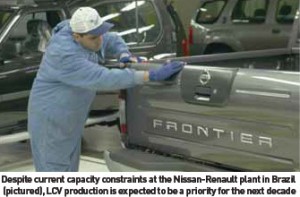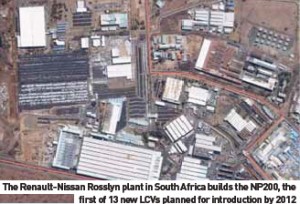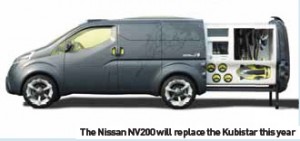
As the global vehicle manufacturing business suffers, Nissan’s light commercial vehicle division is bucking the trend, investing heavily in new plants and product programmes from North Africa to North America. Andy Palmer, the head of this business unit, explains how Nissan plans to leapfrog its rivals to become the number one LCV brand in the world
Nissan Motor’s light commercial vehicle (LCV) business has, over the past two years, steadily emerged as one of the firm’s most successful divisions, a far cry from earlier this decade when it was a chronic loss maker. In 2008, the company made LCVs a standalone global division, giving it highly ambitious profit, customer satisfaction and sales goals. Leading the unit is Andy Palmer, the Programme Director of the global LCV business unit (BU) and the President of Nissan Light Truck Company.
The first Nissan vehicle was in fact an LCV, the 1934 Datsun 13T, with Datsun trucks also the first models to be exported in 1958. In parts of the world such as southern Africa and Australia, the brand’s pickup trucks and cabover vans earned hard-won reputations as extremely tough workhorses, dating as far back as the 1960s. In Japan, meanwhile, the adoption of a unitised body in the production of the first-generation Caravan delivery van was revolutionary in 1973, while Nissan Diesel (since sold to Volvo Trucks) pushed equally hard into export markets throughout South East Asia in the 1980s and 1990s.
 Dr Andy Palmer, 45, is Corporate Vice-President at Nissan Motor Company, with specific responsibilities for Nissan’s global light commercial business. As head of the LCV unit, Palmer has responsibility for the complete business value chain. The unit has a turnover of circa ¥600 billion a year.
Dr Andy Palmer, 45, is Corporate Vice-President at Nissan Motor Company, with specific responsibilities for Nissan’s global light commercial business. As head of the LCV unit, Palmer has responsibility for the complete business value chain. The unit has a turnover of circa ¥600 billion a year.
Having joined Nissan in 1991 as Business Administration Manager at the Nissan Technical Centre Europe (NTCE) in Cranfield, UK, Palmer became Deputy Managing Director of NTCE in 2001 after managing many technical functions within the company. In September 2002, he transferred to Japan as Programme Director for LCVs and was appointed President of Nissan Motor Light Trucks the following year while retaining his duties as Programme Director. Nissan Motor Light Trucks, a joint venture between Nissan and Nissan Diesel located in Ageo, Japan, is responsible for vehicle development of Nissan’s global light-duty trucks.
In April 2004, Palmer established the LCV business unit within Nissan and in April 2005, he was promoted to Corporate Vice-President in charge of the unit. As well as these duties, he serves on the board of directors at Nissan Light Trucks and is a member of the board of Dongfeng Motor Company and DFAC.
After the period of consolidation and targeted growth for the car unit that followed the creation of the Renault-Nissan alliance in the late 1990s, efforts are now being concentrated into making the global LCV BU a major force for growth. To get there, Nissan is taking a multi-pronged approach, with a network of alliances, a complex array of future products in all classes up to eight tonnes gross vehicle weight (GVW), and plans to become the leader by various definitions in each of the markets it has chosen to target. With those countries or regions already listed as Japan, South Africa, Russia, Mexico, India, China, Europe and America, it’s vital that the unit has strong, central leadership. Andy Palmer, who is based in Yokohama, Japan, believes Nissan’s globally focussed but regionally concentrated approach is key.
“The Nissan LCV BU committed to grow volumes to 434,000 units in fiscal year 2007, a 40 per cent increase on the 312,000 produced in 2004, and to double the consolidated operating profit (COP) margin to eight per cent in the same period,” he says. “Both targets were surpassed one year ahead of schedule, in fiscal year 2006, when Nissan LCV sold 490,000 units globally with a COP in excess of eight per cent.
“We’re aiming to achieve a leading position in the global LCV business by 2010. At present we have a significant presence in China, Japan, Europe and Mexico. We see great opportunities in America, where we plan to launch three new products in three years from 2010, in Russia, where we launched sales in September, and in India, where we have a strategic alliance with Ashok Leyland and where we will start LCV operations in 2010.”
According to Palmer, Nissan now covers over 73 per cent of global markets, if you include Nissan’s alliances with Mazda, Isuzu, Mitsubishi and, of course, its partnership with Renault. But of that remaining 27 per cent, a hugely tempting chunk is made up of the currently recessed but nevertheless giant American market.
“We have a production blueprint that can globalise functions to maximise efficiency and deliver greater value to the customer,” he says. “Earlier this year, we announced an investment of $118.5 million (£79.8 million) to convert and expand the Canton plant in Mississippi to an LCV plant.”
Nissan LCVs business unit has established a network of manufacturing facilities and greenfield projects that will source local manufacturing talent and resources in a bid to make LCVs of a high standard while enhancing value. Its global facilities include the following sites:
Japan
Nissan Shatai Company
Nissan Motor Company Kyushu Plant
Nissan Motor Light Truck Company
Nissan Diesel Motor Company (to Volvo Group)
Rest of Asia
Dongfeng Automobile Company (China)
Zhengzhou Nissan Automobile Company (China)
Yulon Motor Company (Taiwan)
Siam Nissan Assemblies Company (Thailand)
Tan Chong Motor Assemblies Sdn Bhd (Malaysia)
Universal Motors Corporation (Phillipines)
Europe
Nissan Motor Iberica (Spain)
South America
Nissan Mexicana (Mexico)
Renault SA Curitiba Plant (Brazil)
Middle East
Para Khodro Company (Iran)
Africa
Africa Nissan Motor Company (South Africa)
Nissan Motor Egypt (Egypt)
Kenya Vehicle Manufacturers Ltd. (Kenya)
Successful worldwide partnerships
While Palmer is reluctant to be drawn on details of the new vehicles for North America, it’s clear that the NV2500 concept, due to be introduced at the Nissan Technical Center in Farmington Hills, Michigan, last December, provides some major clues about the first product. A full-sized van, the new model will challenge the long-time leaders in this segment, GM’s Chevrolet Express and GMC Savana twins, as well as the Dodge Sprinter and Ford Econoline. The potential is huge – even in the worst new-vehicle market since 1983, Ford, the sales leader, sold more than 8,000 units of the Econoline in October 2008 and just under 110,000 in the first ten months of the year.
While Nissan intends to go it alone in the American market, in other markets it continues to be something of a serial partner seeker. In Japan, its alliances include supplying Mitsubishi with a version of its AD Van at the contracted rate of 3,000 units per year. In return, Mitsubishi provides 4,000upa of its Town Box microvan rebadged as the Nissan Clipper Rio. Palmer insists that even at these levels, such relationships make economic sense, especially with the Japanese market still in contraction mode. Further, thanks to such relationships, Nissan is able to cherry pick in the most lucrative segments, while keeping spending low in areas where profits might otherwise be marginal. Other examples abound, especially in regions where Nissan has not been a major player in the past.
“We have leveraged a partnership with Volvo (Trucks) in the development of dealer networks in Europe. In the field of technology, we have a partnership with ZF for drivetrains and hybrid technology and with Cummins for powertrains,” says Palmer.
While Nissan’s approach to sharing technology and even manufacturing operations is flexible, its system also means that regional units provide facilities for product development, manufacturing and marketing support to the LCV BU in Japan.
“The LCV BUs across regions contribute in specific ways to the LCV business at Nissan,” he says. “The BU in North America is responsible for engineering, product planning, value chain management, sales and distribution as well as marketing and aftersales. The BU in Europe provides all these functions, barring distribution, whereas the BU in Japan provides all the functions of the North American BU as well as some production functions.
“We are led by the needs of the customer and our commitment to maximise efficiency at all levels. We view product development as a commitment to the customer to translate his or her requirements into a range of LCVs which are high on functionality and reliability, while making optimal use of new technology with designs based on easy adaptability and a human touch. Of course, this core principle manifests itself in various ways. At times it means that we develop a product like the Cabstar, which is a standardised approach in LDT trucks as they exist in Thailand, Mexico and Japan. On the other hand, the American market has very specific needs and LCVs will need entirely different configurations there.”
Some of the most ambitious plans Nissan has for its LCV division are currently being put in place in Russia, where the brand was launched in September 2008. The first two vehicles there were the NP300 (pickup) and the Cabstar light-duty truck. The range will be extended to six products by the end of 2011, by which time the local market is forecast to be easily the largest in Europe, pushing past Germany towards 4.5 million vehicles.
Another of the so-called BRIC markets, India, holds even more promise for Nissan over the longer term, but it will have to start there from its current minimal presence. Nevertheless, it has chosen one of the most experienced partners in the business, The Hinduja Group subsidiary Ashok Leyland, which will itself be branching out from its heavy truck area of specialisation towards lighter commercial vehicles. Sales there are due to get underway in 2010.
 Nissan and the future Hinduja Leyland (the company’s name is due to change shortly to refl ect its parent’s identity) have acquired 380 acres (154 hectares) of land from the government of the state of Tamil Nadu. The two plants that are currently under construction at Pillaipakkam, 40km from Chennai, will build light commercials and their powertrains.
Nissan and the future Hinduja Leyland (the company’s name is due to change shortly to refl ect its parent’s identity) have acquired 380 acres (154 hectares) of land from the government of the state of Tamil Nadu. The two plants that are currently under construction at Pillaipakkam, 40km from Chennai, will build light commercials and their powertrains.
Production is set to begin in 2010-11 and will include the new-generation Nissan Atlas F24 light-duty truck, in addition to a range of products covering applications from 2.5 to eight tonnes gross vehicle weight. Exports are expected to account for 20 per cent of the fi rst phase of the plant’s initial 100,000upa vehicle capacity.
In September, barely a month after holding the ground-breaking ceremony for the Indian plant, Nissan reached a strategic point in its plans for the third of its three targeted major emerging markets, China. Another ground breaking ceremony, this time that of the Zhengzhou Nissan Company (ZNA) joint venture that the firm has established with the government-controlled Dongfeng Motor (also Nissan’s car production partner). By late 2010, the 120,000upa facility that is currently being erected at Zhengzhou in Henan Province, China, is expected to start producing its fi rst vehicles. Combined with its existing LCV production capacity in China, this will give ZNA annual production of 200,000 LCVs by 2010.
The first Nissan model to be produced at the Zhengzhou plant will be a multi-functional vehicle badged as both a Nissan and a Dongfeng. Exports are planned.
Due to the complications of having to partner with state-controlled firms in the command economy of China, Nissan has been cautious and clear in its dealings with Dongfeng, defi ning the LCV business in detail as part of PLAN 13, the mid-term business plan for Nissan in China. Under this arrangement, the Nissan brand serves the higher-priced LCV segment, while Dongfeng-branded vehicles are marketed as cheap, basic models. By 2012, five, possibly six light commercials are due to be launched by the joint venture, while just as importantly, dealer numbers are due to rise dramatically to 630 by the same year.
While as yet nothing has been announced, the obvious missing piece of the BRIC puzzle is the booming Brazilian market. Like other OEMs that manufacture passenger cars there, Nissan currently has capacity constraints at its São José dos Pinhais plant in the south of the country.
Part of the Ayrton Senna complex that it shares with Renault, for the moment, all efforts seem to be going into adding more Renault and Nissan passenger vehicles, with LCV production expected to be a priority for the next decade.
Another cornerstone of the strategy Palmer has been tasked to push forward is the continuation and expansion of alliances. But whereas this has often involved using such product sharing deals to enter segments and markets where Nissan was weak or absent, the emphasis is set to change over the medium to long term as the firm seeks to become the global leader in LCVs.
“Nissan will continue to seek OEM opportunities with a view to maximising value for its customers,” he says.
“Partnerships with Volvo in Europe, Isuzu and Mazda, constitute Nissan’s proactive OEM strategy. In the future, we aim to graduate from being an OEM net buyer to a net seller. In fiscal year 2007 we bought 76,067 units and sold 12,152.
In the same year, the LCV BU sold 519,703 units globally with a COP exceeding eight per cent. The NP300 pickup truck (also sold as the Frontier in selected markets) was the best-selling individual Nissan LCV with 71,678 units.
China was the market with the largest portion of LCV sales (151,088 units), followed by Japan (121,790 units). The various alliances and forthcoming production plants the world over clearly give Nissan something of a hedged bet for global LCV sales growth. And despite some dramatic falls in traditionally strong commercial vehicle markets, particularly North America and Western Europe in the latter half of 2008, Palmer remains optimistic.
“Our plans remain on target and our goals, which were very ambitious when we set them, are being reached,” says Palmer. “In fiscal year 2008, despite the huge amount of uncertainty that has affected so many markets, we’re confident we’ll reach 600,000 LCV sales. And if you look at where we were, a loss-making operation lacking direction and competitive product in the 1990s, our LCV business has now acquired a status of a major global breakthrough opportunity for Nissan. The LCV business unit has also over-achieved its eight per cent operating-margin milestone, and there’s no doubt now that it is firmly established as a pillar of our global business. We see a lot of growth ahead.”
 The first of 13 new light commercial vehicles planned for introduction during the Nissan GT 2012 mid-term business plan period ending in 2012 was launched in South Africa in October 2008. The NP200, which is built at the Renault-Nissan Rosslyn plant near Pretoria, is in fact a restyled version of the Dacia Logan pickup.
The first of 13 new light commercial vehicles planned for introduction during the Nissan GT 2012 mid-term business plan period ending in 2012 was launched in South Africa in October 2008. The NP200, which is built at the Renault-Nissan Rosslyn plant near Pretoria, is in fact a restyled version of the Dacia Logan pickup.
Other vehicle programmes known to be among the 13 include Nissan Europe’s forthcoming replacement for the Renault Kangoo-based Kubistar small delivery van, the Nissan NV200. This has been engineered at the Nissan Technical Centre Europe (NTCE) at Cranfi eld, UK. A concept version was revealed at the Tokyo Motor Show in October 2007. The first two plants to build the NV200 will be Nissan Shatai in Japan (2009) and the Renault-Nissan facility near Tangiers, Morocco (after 2010). The latter is currently under construction and due to have a combined car and LCV capacity of 200,000upa.
While NTCE is currently contributing to the fi nal development phase of the NV200, it will soon begin an expanded and central role in the development of a new van series, with particular focus on the European market. In the segments above the current Kubistar, which the NV200 will replace in Europe in the second half of 2009, Nissan is part of a Renault-GM Europe joint venture. This produces the six-year-old X83 (Renault Trafi c/Opel-Vauxhall Vivaro, Nissan Primastar) series that is made at Nissan’s Barcelona plant in northern Spain and GM’s Luton facility in England, as well as the larger, nine-year-old X70 (Renault Master, Opel-Vauxhall Movano, Nissan Interstar) vehicles which Renault makes in Batilly, France.
 Nissan also plans to introduce a hybrid-powered LCV by the end of 2012. A Cabstar Hybrid prototype premiered at the IAA Commercial Vehicles 2008 exhibition in Hanover, but as yet there has been no announcement of production for this specifi c model. Nissan says its hybrid technology will be rolled out progressively within its larger capacity LCVs, while the company is also considering the possibility of introducing all electric propulsion technology into its smaller van ranges.
Nissan also plans to introduce a hybrid-powered LCV by the end of 2012. A Cabstar Hybrid prototype premiered at the IAA Commercial Vehicles 2008 exhibition in Hanover, but as yet there has been no announcement of production for this specifi c model. Nissan says its hybrid technology will be rolled out progressively within its larger capacity LCVs, while the company is also considering the possibility of introducing all electric propulsion technology into its smaller van ranges.
Other future new-model programmes will include replacements for some of the firm’s more venerable Japanese-market LCVs, while Nissan USA will gain three new vehicles from 2010, each of which will be made at the Canton plant. Nissan has partnered with Cummins for the development and supply of two diesel engines, which will meet 2010 EPA and CARB emissions standards. The engines, which will be tailored specifically for Nissan, will be manufactured in America. Nissan also has partnered with ZF Friedrichshafen AG for the development and supply of an automatic transmission.
The new LCV products for the American market will take up the capacity that will become available once the Titan full-sized pickup is discontinued, production of which has collapsed to around 1,000 vehicles a month (down 80 per cent year on year in October 2008). The next Titan will not be related to future Nissan LCVs for the American market as this model is being outsourced to Chrysler. While arch-rival Toyota tries to fi nd ways to lift production at two of its full-sized pickup plants (San Antonio and Princeton), Nissan’s strategy to leave the segment and its cut-throat incentives war and build LCVs instead looks visionary.


































